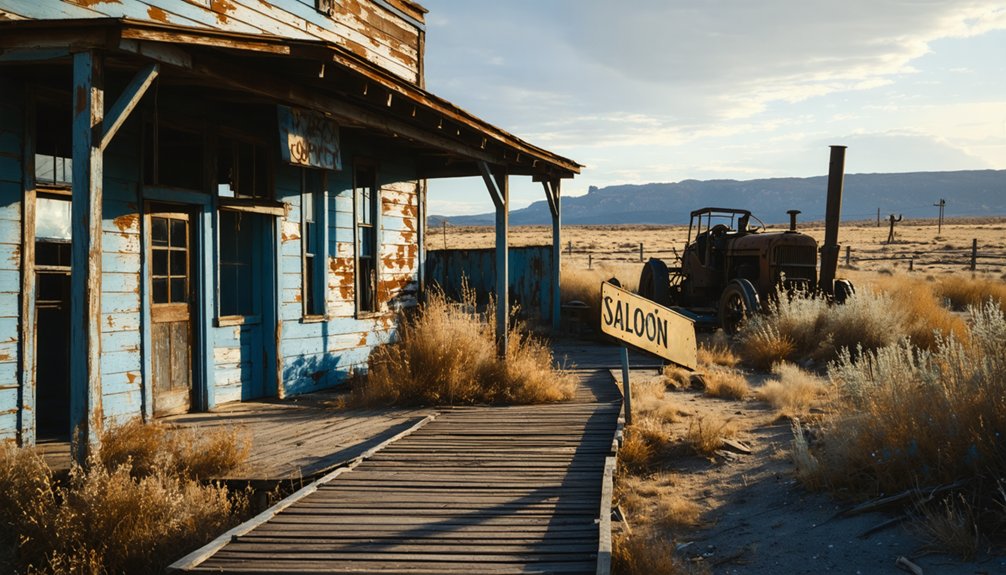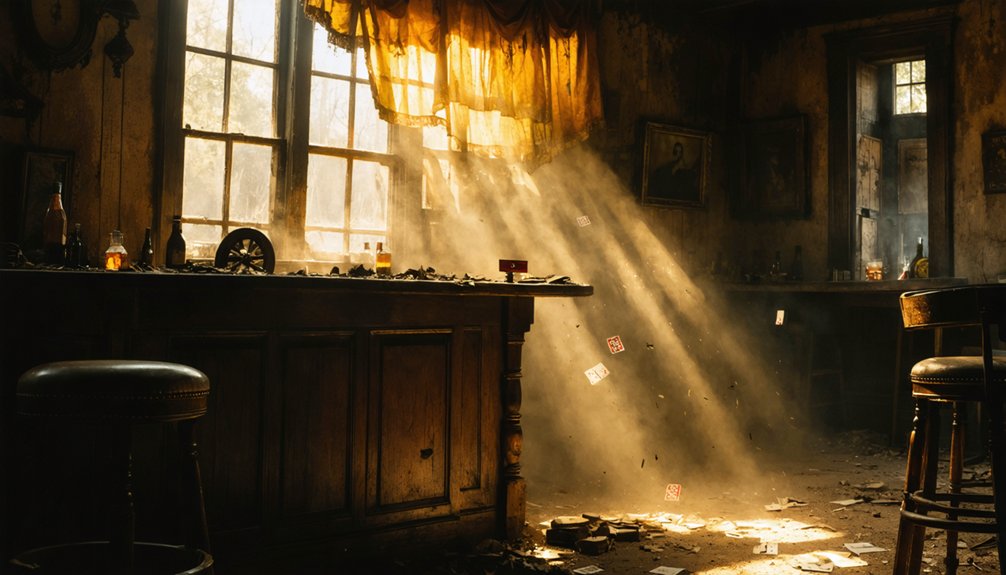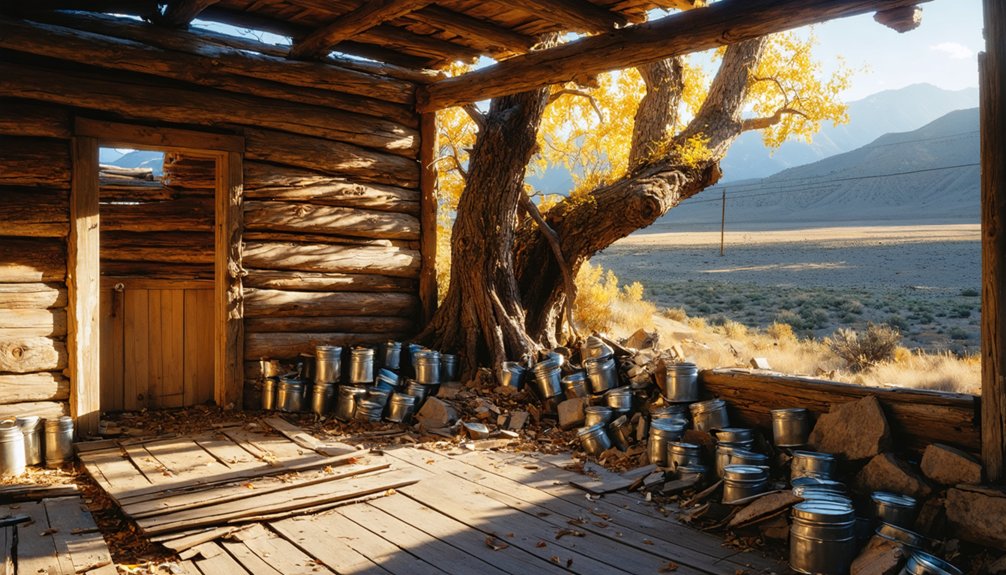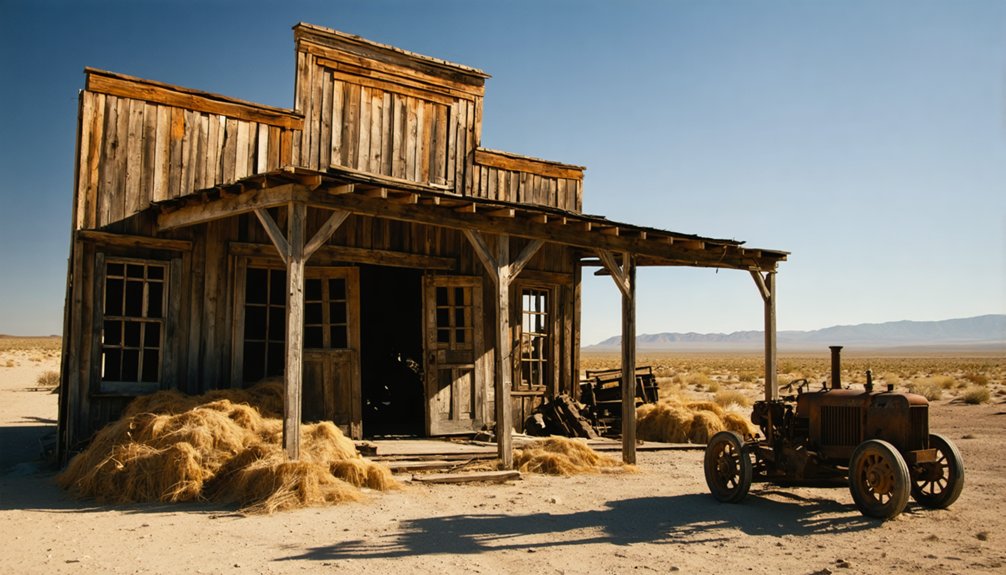Hatfields Camp emerged in California’s Gold Rush era (1840s-1850s) before declining as gold deposits diminished. You’ll find it at 35°28′26″N 117°52′06″W in remote Kern County, though only pastureland remains today where buildings once stood. The site harbors intriguing ghost stories including “Miner’s Midnight Whispers” and spectral lantern sightings. No facilities or markers exist at this abandoned settlement, where three interconnected mysteries continue to perplex visitors for generations.
Key Takeaways
- Hatfields Camp was a Gold Rush-era mining settlement established in the 1840s-1850s that later became a ghost town.
- Located at 35°28′26″N 117°52′06″W in remote Kern County, the site now contains only pastureland with no visible historical structures.
- The camp declined after gold resources diminished and corporate mining operations replaced individual prospectors.
- Ghostly phenomena reportedly include spectral lanterns, disembodied voices, sudden cold spots, and the “Miner’s Midnight Whispers.”
- Originally named Camp Washington, the settlement featured saloons, stores, and thirteen ore processing mills by 1858.
The Birth of a Mining Settlement: How Hatfields Camp Emerged
Countless mining settlements dotted California’s landscape during the Gold Rush era, and Hatfields Camp emerged as one of these hopeful communities in the late 1840s to early 1850s.
Like many of its contemporaries, the camp sprang up beside gold-bearing streams where you could leverage natural water flows for placer mining techniques.
The settlement dynamics followed familiar patterns—prospectors staked individual or small-group claims, then built outward as their efforts proved profitable.
The camp likely bore the name of an early successful miner or prominent claim holder, a common naming convention of the time.
What began as clusters of tents and makeshift shelters gradually evolved as mining operations expanded.
You’d have found Hatfields positioned strategically between essential resources: water for sluicing and promising deposits awaiting your shovel and pan.
Miners initially used simple panning methods before transitioning to more efficient cradles and rockers as operations expanded.
Similar to Horsetown which was established in September 1849, miners at these settlements could earn substantial income of approximately $200 per day through panning methods.
Daily Life and Social Structure in a Gold Rush Community
Life in Hatfields Camp revolved around a complex social structure that emerged from necessity rather than design. You’d wake before dawn to begin your physically demanding labor, working your claim until nightfall under the miners’ code that governed ownership rights. Your claim remained yours only while actively worked—abandonment meant losing everything.
Community dynamics formed around makeshift saloons and stores where Saturday nights offered brief respite from isolation through gambling, drinking, and occasional dances. Many miners turned to humor as coping when facing the harsh realities of mining life. Merchants like the Murphy Brothers accumulated wealth by selling provisions, earning up to $400 a day in Gold Dust.
Saturday nights transformed dusty saloons into vital social hubs, where miners sought connection through cards, whiskey, and rare dancing.
You’d face daily struggles with poor nutrition, illness, and psychological strain, with no formal healthcare available. The camp’s diverse population—about 25% foreign-born—created both cultural richness and tension.
Disputes over claims often ended in threats or violence, with justice enforced communally rather than legally. Your standing in camp depended largely on your success and entrepreneurial initiative.
Mining Operations and Economic Activities
While placer mining initially drew prospectors to Hatfields Camp, the discovery of quartz veins in the mid-1850s transformed the settlement into a hub of industrial extraction typical of the California Mother Lode region.
You’d find mining techniques evolving rapidly, with primitive arrastras giving way to water-powered mills and eventually steam-driven operations. By 1858, thirteen mills processed ore throughout the district.
Walking through Hatfields during its prime, you’d encounter:
- Billowing smoke stacks from 40 to 80-stamp mills crushing quartz day and night
- Teams of miners supervised by foremen extracting gold worth thousands of dollars
- Water diversion projects feeding the voracious appetite of hydraulic operations
The introduction of cyanidation in 1896 revolutionized ore processing methods, replacing the less efficient chlorination process previously used throughout the region.
Hydraulic mining similar to that used in Springfield left severe landscape scarring throughout the area as miners transported gold-bearing dirt to processing locations.
This economic sustainability wouldn’t last forever. When World War I arrived, most operations shut down, leaving behind the ghost town you can explore today.
Notable Characters and Colorful Tales From Hatfields’ Heyday
Beyond the industrial machinery and economic activities that defined Hatfields Camp, the human stories paint a vivid portrait of frontier life during the gold rush era.
You’ll discover notable personalities like the saloon owners who operated essential social hubs where miners gathered after exhausting shifts. These establishments hosted colorful characters and became centers for entertainment and occasional brawls. The town was actually first known as Camp Washington before evolving into its current historical identity.
Mining folklore abounds with tales of prospectors who struck it rich and those who lost everything on a hunch. Chinese miners brought distinctive techniques before facing discrimination that eventually drove them away.
Fortune and failure danced together in these hills, where Chinese ingenuity withered under prejudice’s harsh gaze.
Ghost stories and legends of buried treasure emerged after the town’s decline, sustaining modern interest in this abandoned settlement. The last stagecoach’s arrival in 1914 marked a pivotal moment, as automobiles began transforming the isolated community’s connections to the outside world. Similar to other locations that experienced sudden population decline, Hatfields Camp represents the boom and bust cycle characteristic of many California ghost towns.
The Slow Decline: When the Gold Ran Out

As the golden promise that once drew thousands to Hatfields Camp began to fade in the early 1850s, the community faced an inevitable truth confronting all mining settlements: gold was a finite resource.
The miners’ code—requiring continuous work to maintain claims—became increasingly difficult to uphold as surface placer deposits vanished and economic shift loomed.
You would have witnessed this mining legacy unfold through:
- Abandoned sluice boxes collecting dust as their owners departed for new territories
- Once-bustling saloons standing empty while merchants packed their remaining inventory
- Hillsides scarred by hydraulic mining attempts—desperate final efforts to extract diminishing returns
When corporate mining operations with expensive technologies replaced individual prospectors, Hatfields Camp’s fate was sealed. The transition from simple placer mining techniques to complex hard rock mining processes required resources that few individual miners possessed.
The environmental damage from years of mining activity permanently altered the landscape, with clogged rivers and disrupted watersheds contributing to the area’s abandonment.
The boomtown economics collapsed as quickly as they’d flourished, leaving behind the ghost town you can explore today.
What Remains Today: Exploring the Physical Remnants
What truly remains of Hatfields Camp today might surprise visitors expecting to find the typical weathered structures or crumbling foundations common to California’s ghost towns.
Your site exploration will reveal only pastureland where buildings once stood, with nature having reclaimed every physical trace of the settlement. Located at 35°28′26″N 117°52′06″W in remote Kern County, this barren site offers no visible foundations, artifacts, or historical markers to document its past.
Unlike more preserved ghost towns, Hatfields Camp exists now primarily in historical records rather than physical form.
No archaeological surveys have been conducted, and you’ll find no interpretive signs highlighting its historical significance. The absence of maintained access roads or facilities further emphasizes how completely this once-active community has vanished from the landscape.
Ghost Stories and Legends of Hatfields Camp

As you wander the silent paths of Hatfields Camp after dusk, you might catch the faint sounds of pickaxes striking rock or hushed conversations from miners who haven’t quite left their claims behind.
These “Miner’s Midnight Whispers” often accompany reports of spectral lanterns bobbing between abandoned structures, leading some visitors on fruitless searches for what locals call the “Phantom Gold Rush.”
The legends specifically warn that following these ghostly lights can lead you to dangerous mine shafts or collapsed tunnels—perhaps explaining why the spirits of unfortunate prospectors still linger in this forgotten corner of the Gold Country.
Miner’s Midnight Whispers
Whispers of the past echo through the abandoned mine shafts of Hatfields Camp when darkness falls over the Sierra foothills.
Local historians note that while documented accounts of paranormal activity remain scarce for this specific location, visitors often report unusual experiences they can’t easily explain.
These ghostly encounters typically occur near the collapsed northern mine entrance, where eerie sounds resembling pickaxes striking stone sometimes emerge from the sealed tunnel.
- Cold spots that appear suddenly even during summer nights, moving through the camp like invisible miners walking their old paths
- Faint lantern lights visible in the distance that vanish when approached
- Disembodied voices that seem to call out names or numbers, possibly referring to long-forgotten claim stakes
The historical record may be silent, but the night certainly isn’t.
Phantom Gold Rush
The legend of Hatfields Camp’s “Phantom Gold Rush” encompasses three distinct but interconnected mysteries that have perplexed visitors for generations.
As you wander through the abandoned settlement, you’ll encounter tales of phantom riches that lured countless prospectors to financial ruin. The gold here wasn’t merely scarce—it was deceptive, appearing promising in initial surveys but vanishing during extraction attempts.
The camp’s ghostly reputation stems from reports of spectral miners continuing their eternal search, their phantom tools echoing through empty buildings at night. You might hear whispers of miners who disappeared while pursuing elusive veins, their spirits now warning visitors of cursed locations where gold reveals itself but can’t be claimed without misfortune.
These legends blend geological facts with frontier superstition, creating the perfect backdrop for your ghost town exploration.
Photography Guide: Capturing the Essence of an Abandoned Town
Photographing ghost towns like Hatfields Camp requires careful preparation and technique to truly capture the haunting beauty and historical significance of these abandoned places.
Forgotten places speak volumes when viewed through a patient lens and respectful perspective.
When exploring with your camera, arrive during golden hours when soft light casts long shadows across weathered structures, revealing their abandoned beauty and texture.
- Position your tripod low to frame dilapidated doorways against vast desert skies, creating dramatic compositions that emphasize isolation.
- Seek out intimate details—rusted hinges, faded signage, and time-worn tools—that silently narrate the town’s historical significance.
- Use long exposures at dusk to capture star trails above crumbling structures, merging the town’s past with the eternal night sky.
Pack cleaning supplies, as desert dust will constantly challenge your gear’s performance.
Visiting Hatfields Camp: Practical Information for History Enthusiasts

Exploring Hatfields Camp goes beyond capturing its visual essence—you’ll need practical knowledge to make your visit both rewarding and safe.
Located near Julian in the Sierra Nevada mountains (33.05°N, 116.65°W), you’ll need to navigate unpaved forest roads that often demand high-clearance vehicles.
Proper visitor preparation is essential: bring water, food, first-aid supplies, and wear sturdy footwear to navigate the uneven terrain.
Be aware that cell reception is limited, so inform someone of your plans beforehand.
The site features only stone foundations and scattered artifacts—all protected under historical preservation laws prohibiting removal.
While exploring, keep safety paramount by avoiding unstable structures and mine openings.
Afterward, discover nearby attractions including Julian’s Historic District, Volcan Mountain Wilderness, and Cuyamaca Rancho State Park.
Frequently Asked Questions
Was Hatfields Camp Connected to the Notorious Hatfield-Mccoy Feud?
No, you’ll find no connection between California’s Hatfields Camp and the notorious feud origins. Historical records show no family ties linking these West Coast Hatfields to their Appalachian namesakes’ violent dispute.
What Indigenous Communities Occupied the Area Before the Mining Camp?
Despite 2,000+ indigenous people living in regional settlements, you’d find Mountain Miwok and Nisenan tribes occupied Hatfields Camp area. Their Native Tribes maintained sophisticated Cultural Practices including land management before miners arrived.
Did Any Famous Gold Rush Celebrities Visit Hatfields Camp?
Historical records don’t conclusively document any celebrity visits to Hatfields Camp during the gold rush. You’d need to explore local archives to uncover potential connections to famous forty-niners.
Were There Any Major Natural Disasters That Affected Hatfields Camp?
Like a history book with missing pages, you won’t find specific earthquake impacts or flood damage records for Hatfields Camp. No major natural disasters are documented in its brief, obscure mining existence.
How Did Women’s Roles Differ in Hatfields Camp Compared to Other Settlements?
You’d find women’s labor at Hatfields was largely domestic, unlike settlements where women participated in mining or commerce. Social dynamics kept them under tighter company control than in autonomous communities elsewhere.
References
- https://www.camp-california.com/california-ghost-towns/
- https://www.youtube.com/watch?v=WB_nRv-Ekk8
- https://petticoatsandpistols.com/2016/02/22/julian-the-ghost-town-that-escaped/
- https://en.wikipedia.org/wiki/List_of_ghost_towns_in_California
- https://www.youtube.com/watch?v=VrGy4O3MKlE
- https://discover.hubpages.com/travel/Ghost-Towns-in-California
- https://www.youtube.com/watch?v=auJ2qtL8gpI
- https://www.publiclandsforthepeople.org/wp-content/uploads/2015/06/Desert-Fever-History-of-Mining-in-the-CDCA.pdf
- https://en.wikipedia.org/wiki/California_gold_rush
- https://www.britannica.com/topic/California-Gold-Rush



